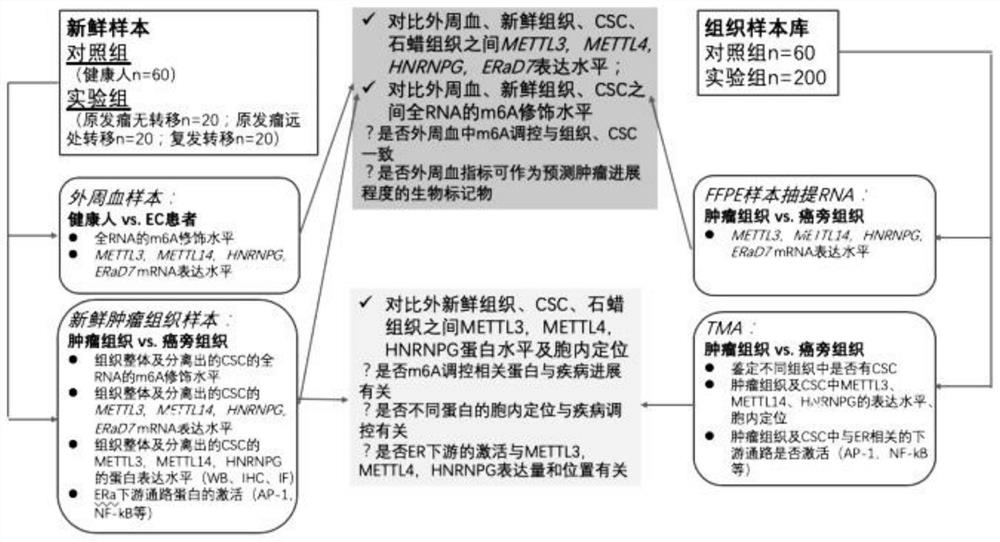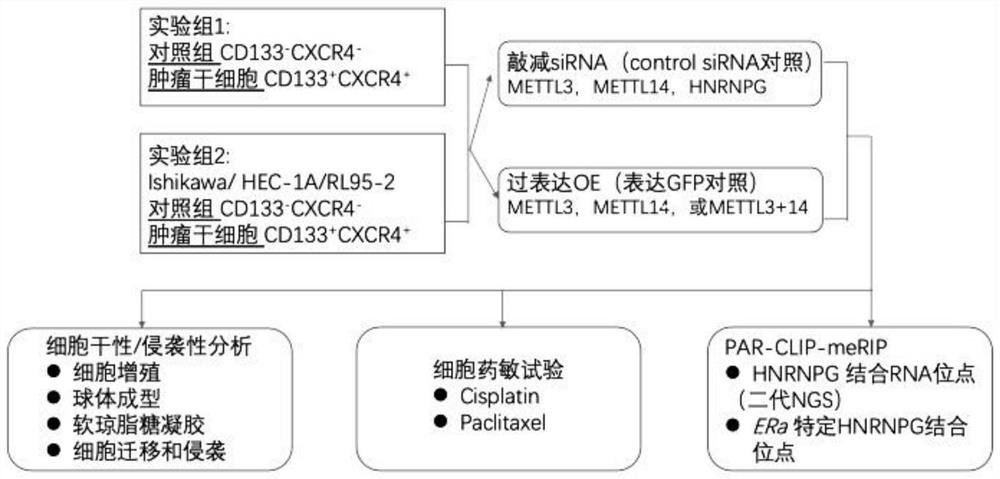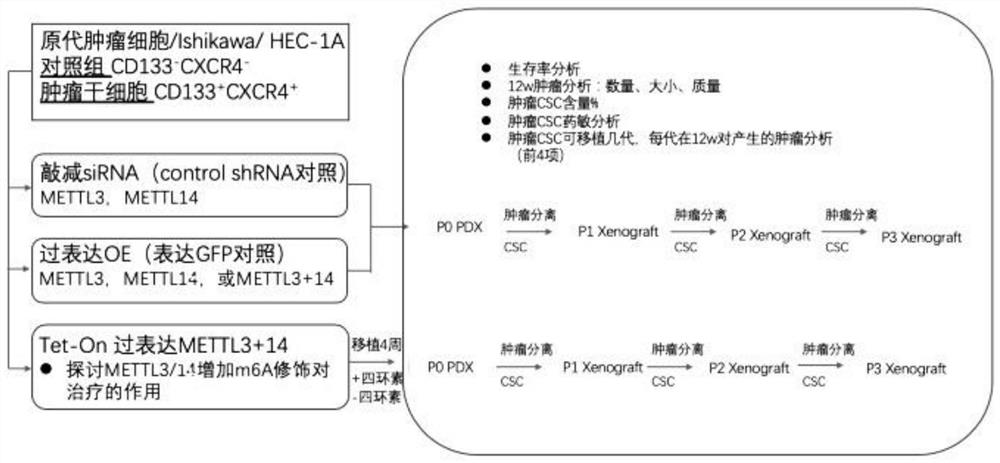Method for studying METTL3 or 14 mediated m6A modification regulation of EC metastasis
A mediation, m6a technology, applied in the field of biomedicine, can solve the problems of reduced affinity between HNRNPG and specific RNA sequences, affecting RNA variable splicing and mRNA expression, and reducing the level of m6A modification
- Summary
- Abstract
- Description
- Claims
- Application Information
AI Technical Summary
Problems solved by technology
Method used
Image
Examples
Embodiment 1
[0070] Such as figure 1 As indicated, the expression polymorphisms of METTL3, METTL14, HNRNPG, m6A, and ERaD7 in EC patients were studied at the clinical level (in the figure, WB: western blot; IHC: immunohistochemistry; IF: immunofluorescence immunofluorescence)
[0071] 1.1 Entry conditions
[0072] Peripheral blood samples:
[0073] Experimental group: Female EC patients aged 18-70 years, with no primary tumor metastasis (n=20), distant primary tumor metastasis (n=20), recurrence and metastasis (n=20), no treatment (at the time of diagnosis) or 7 days or more after receiving radiotherapy or chemotherapy (based on the latest treatment).
[0074] Control group: healthy females aged 18-70, n=60, age matched with the experimental group.
[0075] Both the experimental group and the control group need to meet the conditions: no other diseases (normal function of important organs: heart, lung, liver, kidney, blood), no HIV, HBV, HCV infection, confirmed HPV infection type, no a...
Embodiment 2
[0112] Such as figure 2 As shown, the role of METTL3 and METTL14 in regulating m6A modification and HNRNPG function in tumor metastasis was studied in cell models
[0113] 2.1 Experimental cell grouping and gene knockdown and overexpression
[0114] Experimental group 1: CD133 isolated from fresh tumor tissue + CXCR4 + Cancer stem cells, CD133 in the control group - CXCR4 - tumor cells. Tissues from n=3 patients were taken, wherein n=1 primary cancer without metastasis, n=1 primary metastatic cancer, and n=1 recurrent cancer.
[0115] Experimental group 2: EC model cells, 3 cell lines: 1. Ishikawa cells (Department of Pathology, Peking University); 2. HEC-1A (Shanghai Institute of Cellular Sciences, Chinese Academy of Sciences); 3. RL95-2 cells (ATCC, Manassas, VA, USA ).
[0116] Gene knockdown treatment:
[0117] Group 1: CD133 + CXCR4 + / CD133 - CXCR4 - +siControl,CD133 + CXCR4 + / CD133 - CXCR4 - +siMETTL3,CD133 + CXCR4 + / CD133 - CXCR4 - +siMETTL14, CD...
Embodiment 3
[0142] Such as image 3 As shown, in the PDX mouse model, the regulation of METTL3 / METTL14 affects the ability of EC tumor stem cells to form tumors and metastasize
[0143] 3.1 Experimental grouping and cell processing
[0144] Experimental group 1:
[0145] The primary isolated EC tumor stem cells (CD133 + CXCR4 + ) for METTL3 / METT14 knockdown: a. CD133 + CXCR4 + +pLenti-shRNAcontrol; b. CD133 + CXCR4 + +pLenti-shMETTL3; c.CD133 + CXCR4 + +pLenti-shMETTL14
[0146] Overexpression:
[0147] a. CD133 + CXCR4 + +pLenti-oeGFP; b.CD133 + CXCR4 + +pLenti-oeMETTL3; c.CD133 + CXCR4 + +pLenti-oeMETTL14; d.CD133 + CXCR4 + +pLenti-oeMETTL3+14
[0148] Control group 1:
[0149] Knockdown: a.CD133 - CXCR4 - +pLenti-shRNAcontrol; b. CD133 - CXCR4 - +pLenti-shMETTL3; c.CD133 - CXCR4 - +pLenti-shMETTL14
[0150] Overexpression:
[0151] a. CD133 - CXCR4 - +pLenti-oeGFP; b.CD133 - CXCR4 - +pLenti-oeMETTL3; c.CD133 - CXCR4 - +pLenti-oeMETTL14; d.CD133 - CXCR...
PUM
 Login to View More
Login to View More Abstract
Description
Claims
Application Information
 Login to View More
Login to View More - R&D
- Intellectual Property
- Life Sciences
- Materials
- Tech Scout
- Unparalleled Data Quality
- Higher Quality Content
- 60% Fewer Hallucinations
Browse by: Latest US Patents, China's latest patents, Technical Efficacy Thesaurus, Application Domain, Technology Topic, Popular Technical Reports.
© 2025 PatSnap. All rights reserved.Legal|Privacy policy|Modern Slavery Act Transparency Statement|Sitemap|About US| Contact US: help@patsnap.com



